The Development of Air Power From Balloons to Drones: A Historical Evolution

From reconnaissance balloons during the Civil War to the sophisticated drones of today, the development of air power has transformed military strategy and operations. Air power offers the prospect of military victory without large-scale destruction and loss of life.
This evolution mirrors advances in technology and shifts in strategic thinking.

The early use of balloons provided critical intelligence, shaping the way armies moved and fought.
Over time, innovations like fighter planes and bombers played crucial roles in major conflicts, from World War I and II to the Cold War.
The emergence of unmanned aerial systems has further changed the landscape of air power, allowing for precise operations with minimal risk to personnel.
Modern air power encompasses a broad range of technologies, from stealth fighters to surveillance drones.
These advancements continue to influence how nations project power and ensure security.
Exploring this journey from balloons to drones highlights the relentless innovation that defines air power.
Key Takeaways
- Air power evolved from reconnaissance balloons to advanced drones.
- Technological advancements have significantly influenced military strategy.
- Modern air power includes both manned aircraft and unmanned systems.
Origins and Early History
Air power began with military balloons used for reconnaissance and evolved dramatically by World War I with the introduction of aerial vehicles.
Each phase brought significant advancements in tactics and technology.
The Advent of Military Balloons
In the mid-19th century, balloons first demonstrated their usefulness in military reconnaissance.
During the 1849 attack on Venice, Austria used incendiary balloons in one of the earliest recorded uses of unmanned aerial vehicles for warfare.
They launched about 200 balloons, each carrying explosives.
Later, during the American Civil War, both the Union and Confederate armies utilized balloons for high-altitude surveillance.
These balloons provided a strategic advantage by allowing commanders to observe enemy movements and adjust their strategies accordingly.
The successful use of balloons laid the groundwork for future developments in air power.
World War I and the Rise of Aerial Vehicles
World War I marked a significant shift in the use of air power.
Early in the conflict, tethered balloons continued to be used for reconnaissance and artillery spotting.
However, the real game-changer was the introduction of aerial vehicles like fighter planes and bombers.
By 1915, both the Allies and Central Powers had developed a wide array of aircraft for various military purposes.
These planes were used not only for surveillance but also for direct combat and bombing missions.
The rapid technological advancements during this period were driven by the urgent demands of the war.
The impact of aerial vehicles in World War I set the stage for their expanded role in 20th-century conflicts and established the foundation for modern air forces.
Advancements Between Wars

During the interwar period, notable advancements were made in aviation technology and strategy.
These developments laid the groundwork for innovations seen in the Second World War.
Interwar Period Innovations
Between the World Wars, significant progress was made in unmanned aerial vehicles (UAVs).
One of the first successful UAVs was the Kettering Bug.
Developed in the United States, this aerial torpedo paved the way with its early guidance systems.
Innovation wasn’t limited to the Kettering Bug.
The British Royal Navy developed the Queen Bee.
This drone was used for target practice and also provided valuable data for future developments.
The focus during this period was on enhancing strategic bombing capabilities.
Military strategies were evolving to incorporate precision and efficiency in air strikes.
This shift in strategy highlighted the importance of UAVs in military operations.
Pre-Second World War Developments
As the Second World War approached, the pace of technological advances quickened.
The need for more reliable and effective UAVs grew.
The GB-1 glide bomb, also known as the “grapefruit bomb”, showcased improved range and accuracy compared to earlier models.
Strategies also evolved significantly during this period.
Emphasis was placed on integrating air power with other forms of military force.
The development of UAVs like the Queen Bee and Kettering Bug played a crucial role in testing new strategies and refining aerial combat techniques.
Pre-war advancements were crucial for the widespread use of drones in the Second World War.
New innovations helped refine tactics and improve the efficiency and effectiveness of air power.
The Impact of World War II
World War II significantly advanced air power, leading to improvements in both strategic bombing capabilities and surveillance tactics.
You’ll learn about the crucial roles that aircraft played during the conflict.
Air Power in Strategic Bombing
During the Second World War, strategic bombing emerged as a key tactic.
Aircraft like the B-17 Flying Fortress and the B-29 Superfortress were crucial.
These planes could carry large bomb loads over long distances.
Strategic bombing aimed to destroy enemy infrastructure, such as factories and railroads.
The impact was significant.
Bombing campaigns like the one over Dresden caused massive destruction.
Advanced technology such as radar also allowed for more precise targeting.
The British Royal Air Force and the United States Army Air Forces led many of these missions.
This shift made air power a decisive factor in the war.
The focus was not only on military targets but also on crippling the enemy’s economy.
The use of incendiary bombs further increased the devastation.
In conclusion, the strategic use of aircraft changed the nature of warfare dramatically.
Surveillance and Reconnaissance Tactics
Surveillance and reconnaissance saw major developments during WWII.
Aircraft equipped with cameras were used to gather intelligence.
Planes like the Lockheed P-38 Lightning provided valuable information on enemy positions.
This helped in planning attacks and movements.
Reconnaissance aircraft flew at high altitudes to avoid detection.
Innovations included improved camera technology and faster planes.
This allowed for detailed maps of enemy territory.
Such information was crucial for missions like the D-Day landings.
Surveillance also included electronic warfare.
Devices could intercept enemy communications.
Aircraft played a role in monitoring enemy fleets and troop movements.
Overall, the advancements in reconnaissance improved the effectiveness of strategic planning.
These developments showed how important intelligence gathering had become in modern warfare.
Air Power During the Cold War
Air power underwent significant change during the Cold War, influenced by advancements in jet technology and nuclear deterrence strategies, as well as tactical shifts seen in the Vietnam War.
Jet Age and Nuclear Deterrence
During the Cold War, the military saw the rapid development of jet aircraft.
These jets were faster and had a longer range compared to their predecessors.
The focus shifted toward nuclear deterrence, with efforts centered on creating aircraft capable of delivering nuclear weapons.
The F-105 Thunderchief is a key example.
Initially designed for nuclear attacks, it adapted later to other roles, including bombing missions over Vietnam.
This period established the groundwork for modern air power, ensuring dominance in the skies.
Technological advancements pushed the development of more sophisticated aircraft.
The role of jets in maintaining a balance of power between adversaries was crucial.
Jets like the B-52 Stratofortress became synonymous with the concept of nuclear deterrence.
Their ability to deliver destructive payloads made them a cornerstone of military strategies during this era.
Vietnam War Air Strategies
In the Vietnam War, air power strategies required adaptation to new types of warfare.
Unlike the large-scale, high-altitude bombings typical of earlier conflicts, Vietnam involved close air support and low-intensity operations.
Fighters had to be versatile and capable of precision strikes.
The F-105 Thunderchief was repurposed, excelling in these new roles.
Helicopters and unmanned aircraft also started being used for reconnaissance and combat support, highlighting a shift in how air power was leveraged.
Bombing campaigns like Operation Rolling Thunder exemplified the extensive use of air power.
Precision bombing and support missions were crucial in targeting infrastructure and supply lines.
This period marked a notable evolution in air strategy, showcasing the flexibility and adaptability of air power in varying conflict scenarios.
Development of Unmanned Aerial Systems
Unmanned Aerial Systems (UAS) have evolved significantly since their inception.
From basic target drones during wartime to highly advanced systems like the MQ-1 Predator, the journey is filled with notable innovations and milestones.
Target Drones and Early UAVs
Early UAVs were primarily used as target drones.
In the 1930s, the U.S. Navy used radio-controlled aircraft for training anti-aircraft gunners.
These early efforts laid the groundwork for more advanced systems.
During World War II, the German V-1 “Buzz Bomb” became well-known as a type of unmanned aerial vehicle used in combat.
These examples show how UAVs initially served simple functions but set the stage for more complex missions.
As technology advanced, UAVs began to take on more roles in reconnaissance.
By the Vietnam War, UAVs like the AQM-34 Ryan Firebee were performing photo-reconnaissance missions, showing that these systems could gather valuable intelligence without risking pilot lives.
These stages highlight the gradual shift from manned to unmanned operations in aerial reconnaissance.
The Emergence of Modern Drones
The development of more sophisticated UAVs in the late 20th and early 21st centuries brought significant changes.
The MQ-1 Predator, introduced in the mid-1990s, became a game-changer.
It featured advanced surveillance technology and could be armed with missiles, blending reconnaissance and combat capabilities.
This marked a new era of military strategy.
Modern drones now perform various roles, including intelligence, surveillance, reconnaissance (ISR), and even logistics.
The versatility of today’s UAVs extends to civilian applications, such as disaster relief and agriculture.
These advancements in drone technology are pivotal in modern military and civilian operations, showing the extensive impact of unmanned systems.
The evolution from simple target drones to advanced aerial systems like the MQ-1 Predator underscores the significant technological advances in UAVs over time.
These developments continue to shape modern warfare and civilian applications.
Modern Air Power and Drones

Modern air power has transformed significantly with the integration of drones.
These unmanned aerial vehicles have changed military tactics, offering new capabilities for surveillance, combat, and strategic advantage.
Military Applications and Capabilities
Drones have become essential in military operations due to their versatility and efficiency.
They provide real-time surveillance, enabling commanders to gather critical intel without risking human lives.
These unmanned aerial vehicles can perform targeted strikes with precision, reducing collateral damage.
Modern drones also support logistical missions such as resupplying troops or delivering humanitarian aid in hostile environments.
Advancements in drone technology allow for long-endurance flights, making them ideal for continuous monitoring and rapid response.
The use of drones can lead to quicker military victory while minimizing risks.
Their capabilities include electronic warfare, disrupting enemy communications, and signal intelligence gathering, enhancing overall strategic planning.
Integration of Drones in Modern Warfare
Integrating drones into modern warfare has streamlined operations.
Commanders now rely on autonomous drones for various missions, which can operate with minimal human intervention.
This integration improves response times and operational flexibility.
Drones are increasingly used in joint operations with manned aircraft, creating a more comprehensive air power strategy.
This combination enhances situational awareness and allows for coordinated strikes.
Drone technology continues to evolve, with new models offering advanced stealth features and AI for better decision-making.
These advancements ensure that drones remain a key component in achieving military objectives.
In summary, the role of drones in today’s military environment highlights their importance in achieving precise, efficient, and low-risk outcomes.
By harnessing their full potential, modern air power continues to evolve and adapt to new challenges and opportunities on the battlefield.
Controversial Aspects of Drone Use
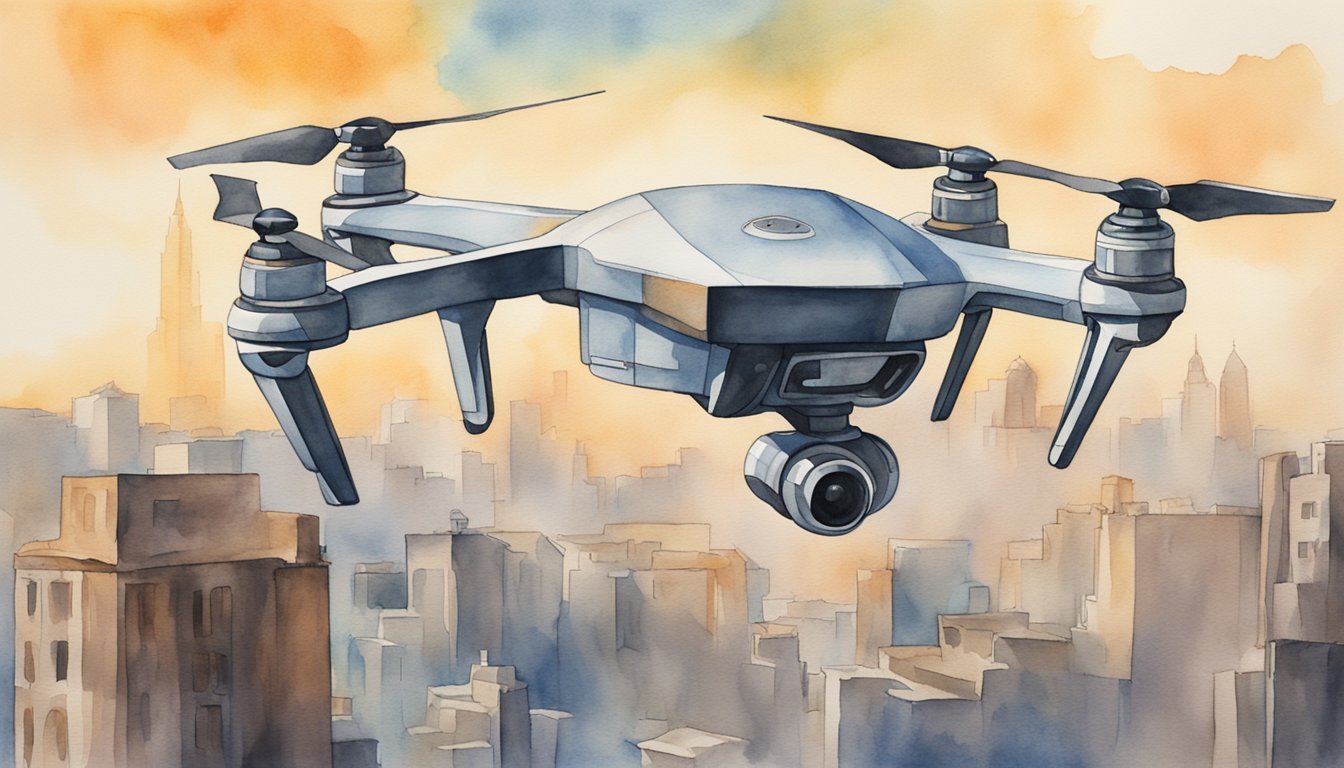
Drones have transformed air power, but their use is not without controversy.
Key issues include legal and ethical debates as well as the impact of civilian casualties, which shape public perception.
Legal and Ethical Debates
The use of drones in military operations raises many legal questions.
International laws, such as the Geneva Conventions, regulate armed conflict, but some argue they don’t clearly cover drone warfare.
This gap leads to debates about whether drone strikes comply with international law.
Ethically, drone warfare challenges traditional views on combat.
Some argue that using drones to carry out strikes removes human operators from the battlefield, potentially making it easier to go to war.
This is often seen as lowering the threshold for the use of force.
Drones are also used for targeted killings, which is a controversial practice.
Concerns revolve around accountability and transparency since decisions involving drone strikes might bypass traditional checks and balances.
Civilian Casualties and Public Perception
Civilian casualties are a significant issue with drone use.
Even with advanced technology, drones aren’t perfect and strikes can result in unintended deaths.
These incidents fuel negative public perception and raise moral questions about the use of drones for combat.
Public perception matters, especially in regions where drone strikes occur.
Local populations may view their use as violations of sovereignty, enhancing anti-Western sentiments.
This impacts the effectiveness of military operations and complicates diplomatic relations.
In many cases, media coverage of civilian casualties can lead to public outcry, influencing policymakers and shaping national and international debates about drone use.
This makes it crucial for military operations to consider both the short-term and long-term implications on public perception when deploying drones.
Role of Air Power in Contemporary Conflicts
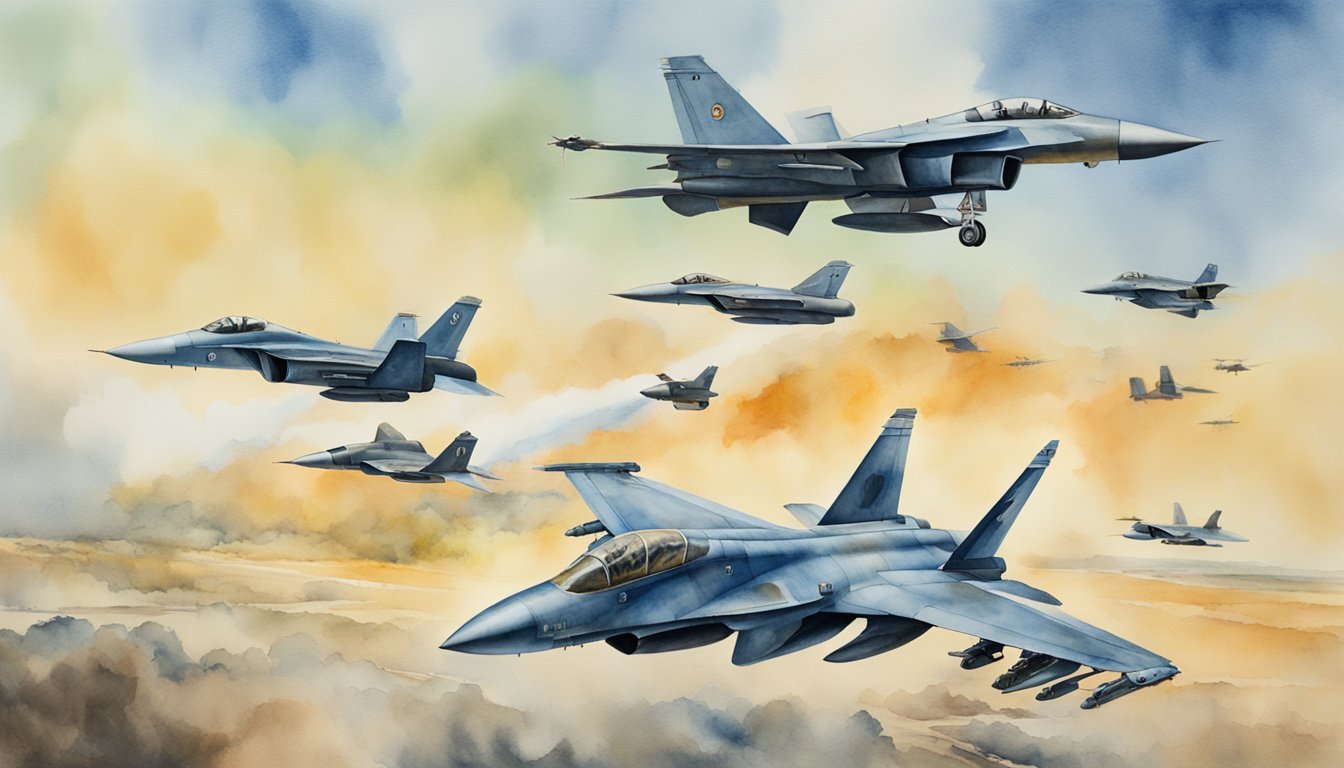
Air power has become integral in modern warfare, offering strategic advantages in counterinsurgency and counterterrorism operations, as well as global surveillance and intelligence gathering.
Counterinsurgency and Counterterrorism
In contemporary conflicts, air power plays a critical role by providing precise and rapid responses.
Using advanced aircraft like the F-35, military forces can quickly strike insurgent targets with minimal ground force engagement.
These operations are crucial in disrupting terrorist networks and supply chains.
Drones have revolutionized counterterrorism efforts.
They allow continuous monitoring and can carry out strikes without risking pilot lives.
This capability is essential in areas where ground troops cannot easily operate.
Drones also offer the benefit of persistent surveillance, enhancing situational awareness and the ability to act on intelligence.
Close air support is another important aspect.
Aircraft provide direct assistance to ground forces, helping to repel insurgent attacks and support troop movements.
This integration between air and ground operations maximizes effectiveness and minimizes casualties.
Global Surveillance and Intelligence
Air power is vital for global surveillance and intelligence.
Advanced aircraft and drones can monitor vast areas, collecting data on enemy movements, infrastructure, and activities.
This information is essential for planning and executing military operations and maintaining strategic advantages.
Surveillance operations often involve satellites and reconnaissance planes.
These tools gather real-time data, which is crucial for decision-making.
The ability to monitor hostile regions from afar allows for effective management of resources and timely responses.
Airborne intelligence gathering supports broader military strategies.
It helps in mapping out enemy territories, identifying potential threats, and tracking the development of weapons systems.
For example, the U.S. uses platforms like the Global Hawk for high-altitude, long-endurance surveillance.
Utilizing air power for both surveillance and intelligence ensures that you can act with up-to-date information, making military operations more precise and effective.
Prospects of Air Power
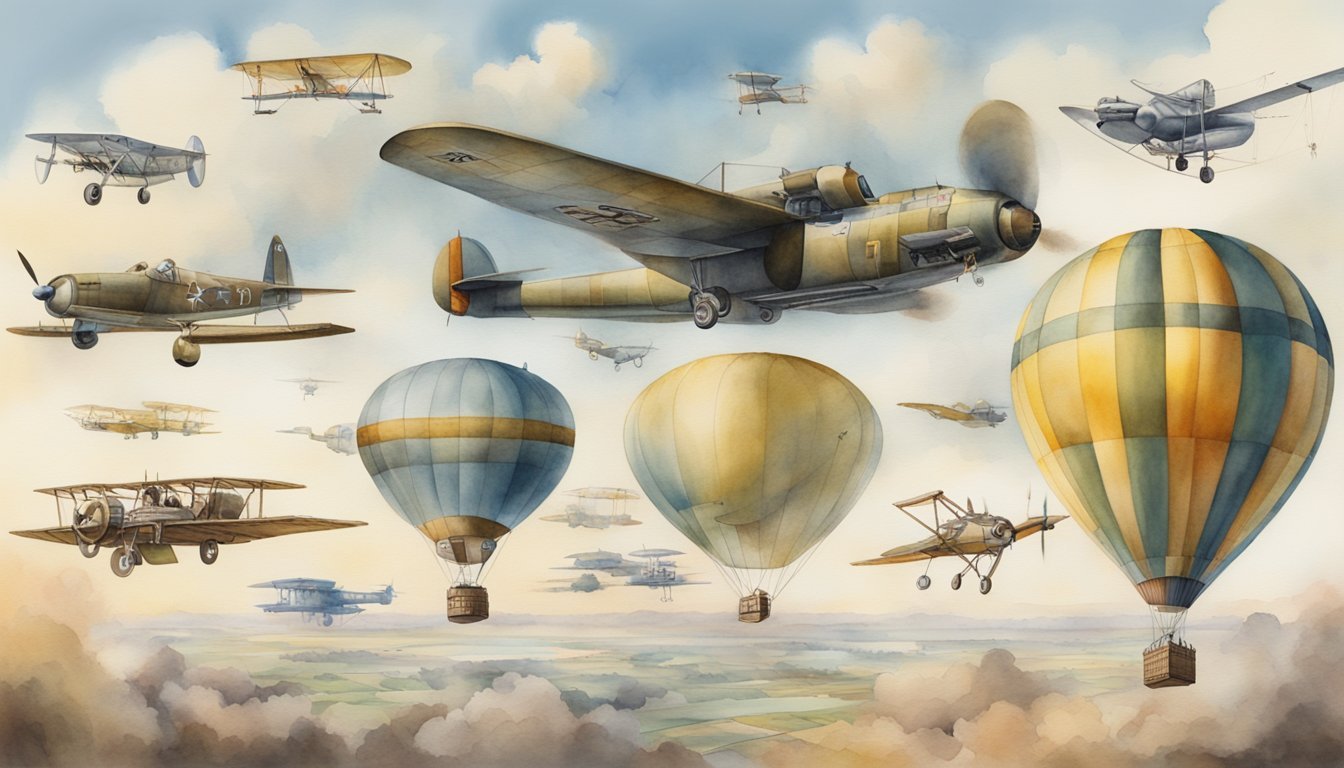
Air power continues to evolve with rapid advances in technology and innovative concepts.
The future promises exciting developments in UAV technology and other futuristic applications.
Technological Advancements and Future Concepts
Air power is increasingly driven by advances in UAV technology.
Unmanned Aerial Vehicles (UAVs) or drones are now capable of sophisticated missions that once required manned aircraft.
These drones perform surveillance, reconnaissance, and even combat roles, reducing risk to human pilots.
As drone technology develops further, expect newer models with enhanced capabilities such as improved stealth, longer flight times, and better data processing.
Futuristic concepts in air power also include artificial intelligence (AI) and autonomous operations.
AI enables smarter, more adaptable drones that can react to changing conditions without direct human control.
Additionally, concepts like swarming tactics, where multiple UAVs operate in a coordinated manner, represent a significant shift in how air power is used.
These advances will likely shape future military strategies and capabilities.
To learn more about the development of air power and its future, you can explore the journey from balloons to drones.
Educational and Scholarly Perspectives
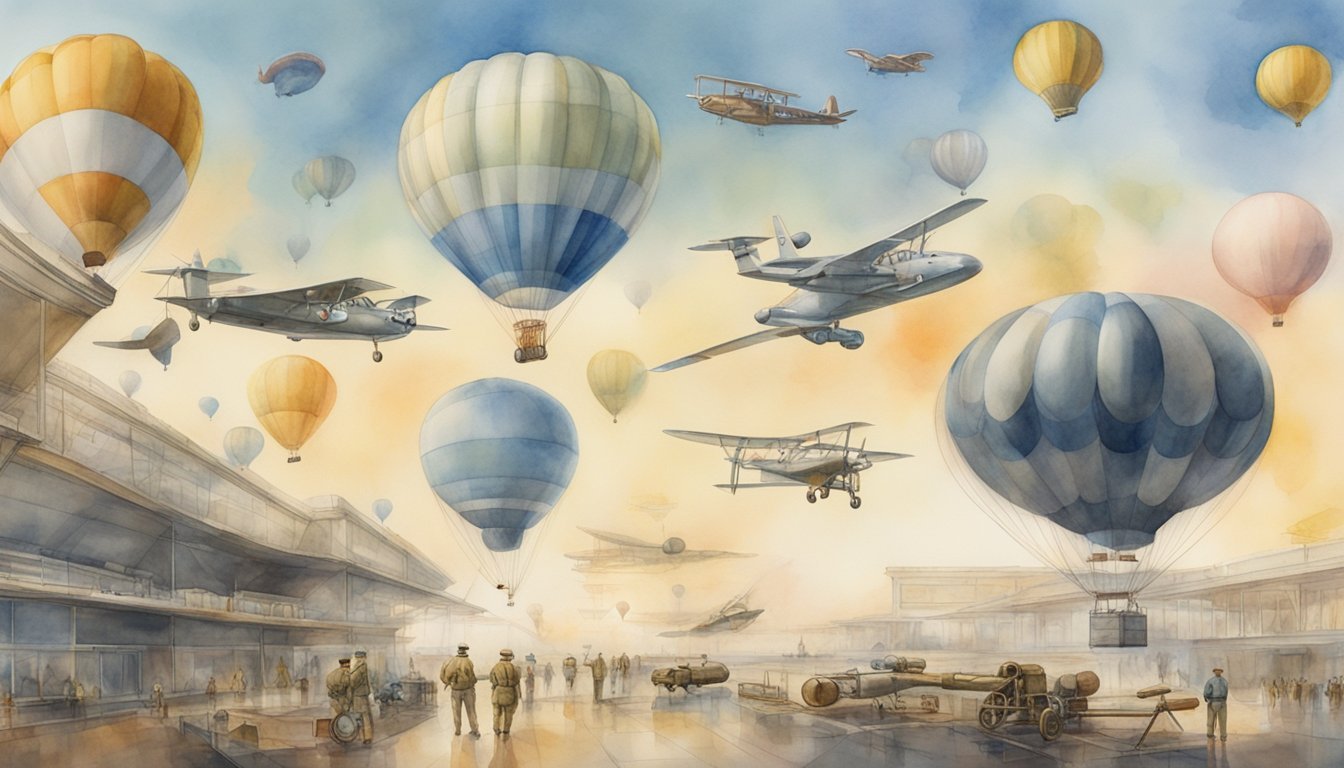
Air power history and theory have been extensively studied and analyzed by both academics and practitioners.
Training programs and educational institutions play a significant role in preparing individuals to understand and use air power effectively.
Academic Research and Analysis
Academic research and analysis on air power encompass a wide range of topics, from historical developments to modern strategic applications.
Scholars publish articles and conduct studies on platforms like From Balloons to Drones, analyzing the evolution of air power from early balloons to advanced drones.
Postgraduate students and academics engage deeply with these topics, examining the impact of air tactics and technology.
Journals and webzines present critical assessments, theories, and debates.
This constant analysis helps refine our strategies and operations.
Training and Educational Programs
Training and educational programs are crucial for developing skilled air power strategists.
Military academies and specialized institutions offer courses on air power theory and practice.
Practical training includes simulated combat scenarios, historical case studies, and the latest drone technology.
Educational initiatives focus on the continual advancement of knowledge and skills.
Programs might include collaborations with platforms like From Balloons to Drones, emphasizing the role of historical insight in shaping contemporary strategies.
Frequently Asked Questions
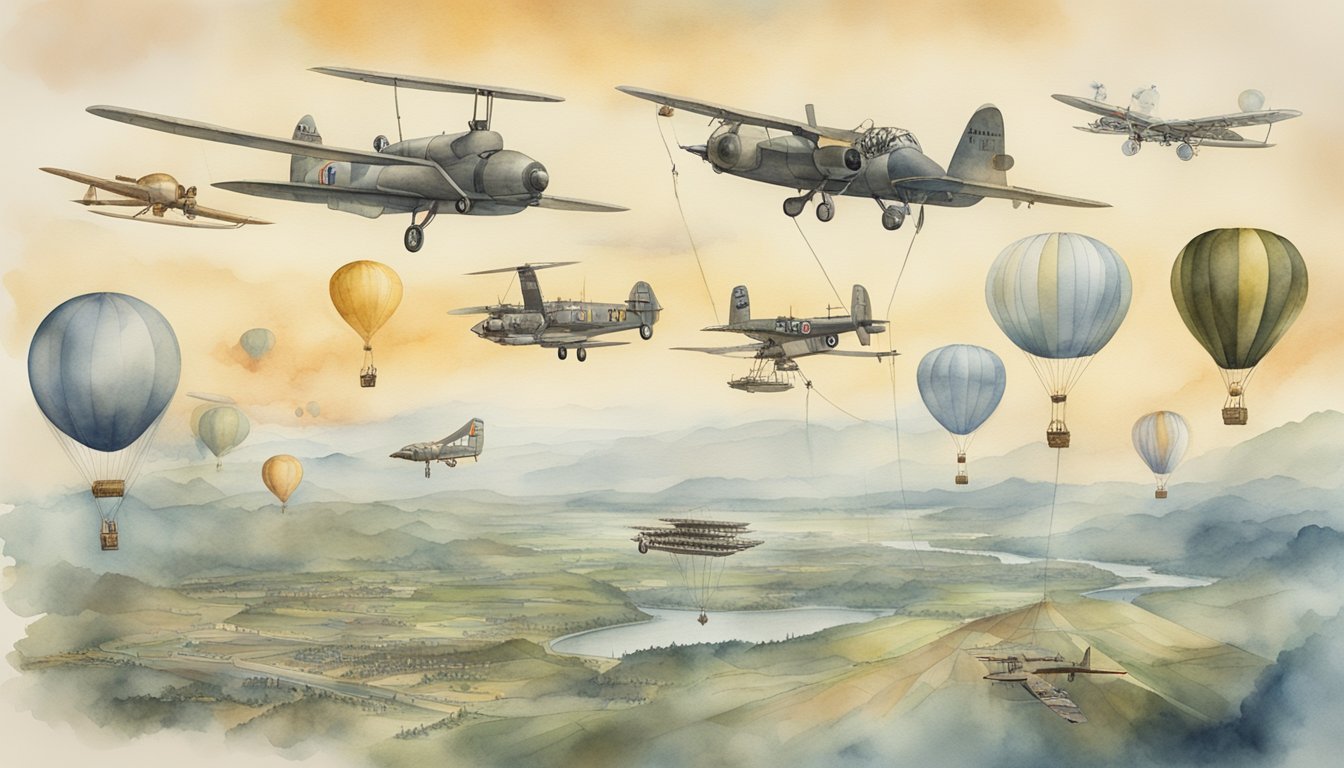
In this section, you will find answers to common questions about the development of air power from the era of balloons to modern drones.
Key advancements, military strategy evolution, and the impact of drones are all covered here.
What were the key advancements in air power technology from the era of balloons to modern drones?
Air power began with balloons used for reconnaissance during the Civil War.
This moved to powered flight with the Wright brothers’ achievements, then to fighter planes and bombers in World War I and II.
Later, jet engines, stealth technology, and finally, drones capable of advanced surveillance and combat operations marked significant milestones.
How has military strategy evolved with the development of advanced air power capabilities?
With the advent of advanced air power, military strategy shifted from large-scale ground battles to air dominance.
Early reconnaissance balloons provided valuable intelligence.
Fighter jets and bombers allowed for strategic bombing campaigns.
Modern drones enable precise, real-time strikes with minimal risk to human pilots, altering the dynamics of warfare significantly.
What role did air power play in the conflicts of the late 20th century, particularly in the Gulf War of 1991?
In the Gulf War of 1991, air power played a crucial role.
Coalition forces used precision-guided munitions and stealth bombers to disable Iraqi infrastructure.
Air superiority allowed for a swift ground invasion with minimal casualties.
This conflict showcased the capabilities of modern air power and set a precedent for future military operations.
How have drones changed the landscape of surveillance and combat in contemporary warfare?
Drones have revolutionized surveillance and combat.
They provide real-time intelligence, surveillance, and reconnaissance (ISR) without risking human lives.
In combat, drones can conduct targeted strikes with high precision.
This capability has made drones indispensable in modern military operations, reducing collateral damage and allowing for more flexible and persistent monitoring.
What are some significant books that chronicle the history and development of air power?
Several books provide in-depth chronicles of air power development. “Air Power: The Men, Machines, and Ideas that Revolutionized War, from Kitty Hawk to Gulf War II” by Stephen Budiansky is one such work. “The Development of Air Power: From Balloons to Drones” also offers valuable insights into this history.
In what ways have air defense systems adapted to counter advancements in offensive air capabilities?
Air defense systems have evolved significantly to counter advanced aerial threats.
Early anti-aircraft guns have given way to sophisticated radar-guided missiles.
Modern systems like the Patriot missile system can intercept various aerial threats, including drones and ballistic missiles, enhancing defense against increasingly advanced offensive air capabilities.

